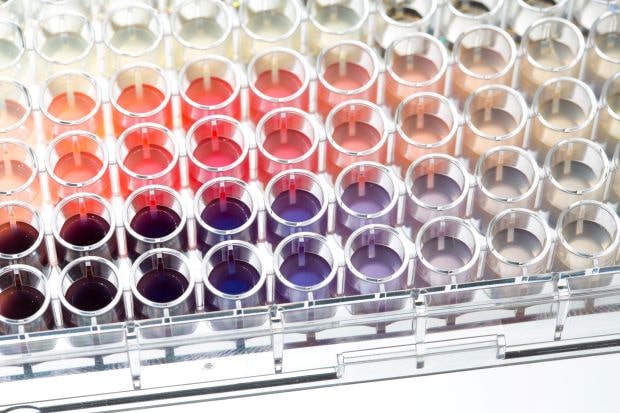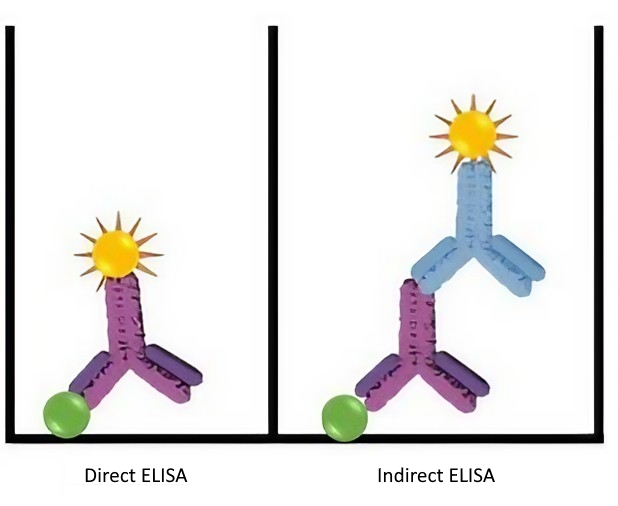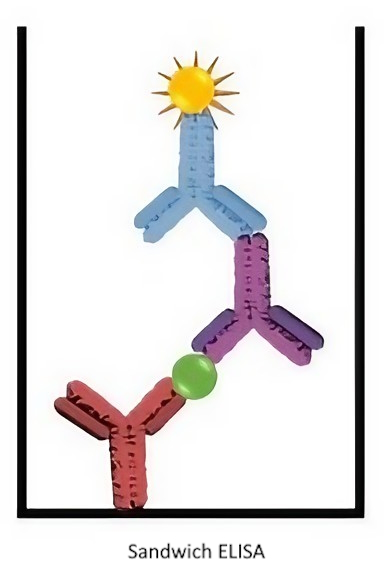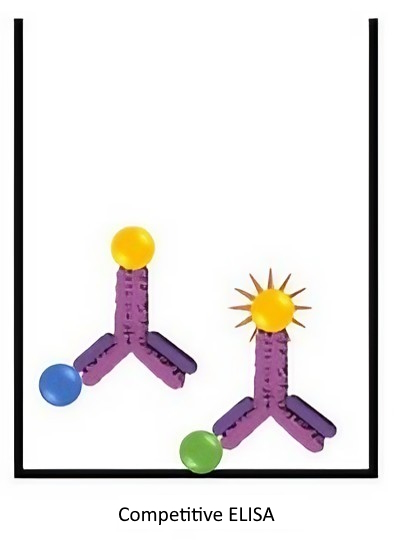ELISA, ELISpot and Alternative Assays
A 2BScientific White Paper showcasing ELISAs and ELISpot
View PDF VersionIntroduction
Based on the observed large national down turn in sales of ELISA related products, this article investigates the meaning and background of this observation. Upon request a comparison is made between ELISA and ELISPOT. This report explains the fundamental differences between the different types of ELISA and how they compare with ELISPOT.
The occurrence in the literature of the different platforms is measured, and compared with the most cited alternatives to ELISA before the most used platforms are evaluated. Emerging alternatives may explain the downturn of ELISA product sales. The assays explained ELISA (Enzyme-Linked ImmunoSorbent Assay) is the method to detect an analyte (usually a protein) by means of an antibody in a 96 well format microtitre plate.
The antibody is then reported back through a secondary antibody coupled to an enzyme that will cause an enzyme-specific substrate to stain the contents in the well (1). The level of staining is proportionate with the content of the analyte and can be measured through absorbance thus providing quantitative analysis. Newer ELISA-like techniques use fluorogenic, electrochemiluminescent, and quantitative PCR reporters to create quantifiable signals.

These new reporters can have various advantages, including higher sensitivities and multiplexing (2, 3). In technical terms, these newer variants of assays are not strictly ELISA, as they are not "enzymelinked", but are instead linked to some non-enzymatic reporter. However, given that the general principles in these assays are largely similar, they are often referred to as ELISA.
There are three different approaches of ELISA:
Direct & Indirect ELISA: With this approach, the analyte is coated in the microwells and detected either directly by an enzyme-conjugated primary antibody, or indirectly by making use of an enzymeconjugated secondary antibody.
A well-established variant is the biotin-(strept-)avidin detection system when the primary is biotinylated, and instead of a secondary antibody, the streptavidin conjugated to an enzyme is used to bind to the biotinylated primary antibody. This system further enhances the sensitivity of the detection method.

Sandwich ELISA: This approach is the most common method for quantitative analysis, as the analyte is captured from the matrix (plasma, serum, or other bodily fluid) by the primary antibody coated in the microwells. Here, the secondary antibody is also directed to the same analyte and report back on the captured molecules. A prerequisite to this approach is that the capturing and reporting antibodies need to bind to different parts of the analyte.
Because there are two different primary antibodies involved, this approach potentially enhances the specificity of the detection. The reporting antibody is either conjugated itself for detection, or it is detected by a conjugated secondary antibody (that should not cross-react to the capture antibody).

Competitive ELISA: In contrast to the above approaches, with a direct correlation between the obtained signal and the amount of analyte in the measured samples, the competitive assay allows added labelled reagent (either antibody or antigen) to compete with the unlabelled reagent in the sample to be analysed. Consequently, high amount of analyte would yield low reading (competed with the labelled added reagent) and a low amount of analyte would yield a high reading (labelled reagent finds low competition). Hence, the calibration curve would show a reverse orientation compared to the other approaches.

ELISPOT
ELISPOT (Enzyme-Linked ImmunoSPOT) is widely used for monitoring cellular immune responses (4), and has found clinical applications in diagnostics and in the monitoring of graft tolerance or rejection in transplant patients. The ELISPOT technique has proven to be among the most useful ways to monitor cell-mediated immunity, due to its sensitive and accurate detection of rare antigen-specific T cells (or B cells) and its ability to visualize single positive cells within a population of peripheral blood mononuclear cells (PBMCs).
The microwells contain a PVDF membrane coated with a capture antibody specific to a cytokine. This cytokine would be released upon activation of a subset of lymphocytes among the PBMCs added and incubated in the microwells. Thus, the presence of such activated cells is detected and counted by the cytokines captured on the membrane at the locations of their origin, assayed as a standard sandwich ELISA after the cells have been washed away.
Occurrence in literature
This study has looked at the last 17 years of publications (2000-2017) as reported by Google Scholar, by recording the number of articles returned using the following key words: “ELISA” plus “Enzymelinked ImmunoSorbent”, “sandwich ELISA”, “competition ELISA” plus “competitive ELISA”, and “ELISPOT”.
Certain papers may have used both keywords when meaning the same (such as “ELISA” and “Enzyme-linked ImmunoSorbent”), in which case such papers are counted double. In this analysis we made sure not to miss the papers where either one without the other is being used. The graph (figure 1) summarizes this study. It appears that the more generic “ELISA” and Enzyme-linked Immunosorbent” has far out the highest frequency of occurrence, but its frequency peaked in the period 2006-2011 and is dramatically decreased since 2015.
Although the frequency of “sandwich ELISA” is an order of magnitude lower than of “ELISA”/”enzyme-linked immunosorbent”, we see the down trend much earlier. Since Google Scholar returns research papers and patents, these frequencies need to be interpreted as a prelude of practical use. In other words, the practical use of such assays in a clinical routine only happens AFTER the research has been settled.
Hence, while the research on such assays decline, their clinical applications may in fact rise, until the market saturates. The keywords “competition ELISA”/”competitive ELISA” and “ELISPOT” show a two-orders of magnitude lower frequency compared to “ELISA”/”Enzyme-linked Immunosorbent”.
Although we see no significant decline, the much lower frequency of occurrence in the literature suggests that a lot of other assays are being used as alternative to these standard ELISA methods.
Alternative assays in literature
Next to research, ELISA is used in both preclinical and clinical applications for the quantitative analysis of analytes at large scale. However, alternatives are also being used. Many analytes, particularly smallweight molecules and non-protein molecules are better detected through other means as antibodies are not always available or fit for detection in ELISA.
Other immune assays that serve as an alternative to ELISA are RIA (radioimmunoassay), Lateral Flow, and Multiplex Assay (Luminex beads). The latter is used for simultaneous detection of a set of different molecules in one go. In addition to such alternative immunoassays, aptamers are increasingly used as a replacement for antibodies (5). The Surface Plasmon Resonance (Biacore instrument) is a method to detect interactions between known molecules.
The most versatile and non-immunological method of detection and identification (and with extreme high sensitivity) is the mass spectrometry. The frequency of articles featuring these alternatives have been scored through Google Scholar, in the same way as above for the various ELISA assay approaches (See figure 2).
The results show strong growth for multiplex, aptamer and lateral flow, while research papers using mass spectrometry has been in decline in recent years, although still an order of magnitude higher than the others.
Evaluation of different assays
Reviews on immunoassays for heparin-induced thrombocytopenia reveal Important differences between classes of immunoassays, type of antibody specificity, thresholds, and manufacturers (6,7). Such variables apply to any analyte, thus there is a tendency to identify or develop more robust alternatives to the traditional immunoassays when possible.
When not possible, the traditional methods (mainly ELISA) are adjusted, for example through a different way of detection (such as (electro-)chemiluminescence, fluorescence, Polymerase Chain Reaction, Surface Plasmon Resonance, ElectroHydroDynamics, or micro-Nuclear Magnetic Resonance), or through scaling down the sample size to address long processing time, high costs, poor user-friendliness, technical complexity, poor sensitivity and specificity associated with the traditional platforms (8).
Over the last decade, various microfluidic-based Point-Of-Care platforms are developed for detecting nucleic acids, proteins, pathogens and cells (9). However, despite the advantages of reduced consumption of reagents and samples, operational automation, cheap unit cost, low power consumption, and compact size, success is still limited by fabrication materials, packaging method, purification/concentration, and reagent storage (9).
But based on the literature (see above), the most cited method is Mass Spectrometry (figure 2). This method is the most powerful one for its versatility (it can be combined with a pre-step of a chromatography method or an immunoassay method), for its high sensitivity, and for the extreme low quantities of biological material that is required for analysis. This makes this instrument fit for the detection and identification of all types of molecules, varying from protein fragments to small steroids, lipids, carbohydrates, etc.
However, the high costs and slow speed is a great limitation, especially for Point-of-Care applications. The other very popular alternative with the strongest growth (figure 2) is the multiplex immunoassay, as it enables high throughput identification of protein biomarkers which is sought after both for diagnostics and companion diagnostics. There is a fundamental distinction to be made between bead-based multiplexing, also known as Suspension Array Technology (in this context using capture antibodies linked to microbeads, for example Luminex) and homogenous sandwich-type multiplexing (using all reagents in solution, thus preventing washing steps).
However, despite its increased popularity, there remain issues around high-throughput validation, matrix interference and cross-reactivity (10). Conclusions Immunoassays are being used based on scientific research, based on preclinical assessments, and based on routine clinical tests. In addition, immunoassays are used in human medical and veterinary context, and in forensic and environmental sciences. Only the results of scientific research will end up in scientific papers, so the assessments of frequency of the different assays in the scientific literature does not reflect accurately the demand in the market. All the use in clinical and pre-clinical applications would represent the major market without any reflection in scientific publications.
That said, the rise and decline of certain assays in the literature do reflect the attention to these technologies in scientific research and the observed decline in mass spectrometry might indicate that most science are to be completed using such instrumentation. This could mean that the mass spectrometry still has an increased role to play in the day-to-day routines. The strong growth of multiplex, lateral flow and aptamer-based assays implies that the increased attention in scientific research is inevitably followed by increased demand when the resulting products are introduced in the day-to-day routine practice.
It is worth noting that all the different types of ELISA have been accompanied with so many different alternatives, that the observed decline in sales of ELISA kits should be seen in this light. It is likely that certain analytes who were originally monitored by sandwich ELISA, are currently being monitored by lateral flow, by aptamer-based assays or by mass spectrometry. One another can be verified by looking at specific products that showed declined sales and to see if alternatives specific to the same marker have emerged in the market. Any comparison between ELISA platforms and ELISPOT is not very helpful as both serve completely different purposes.